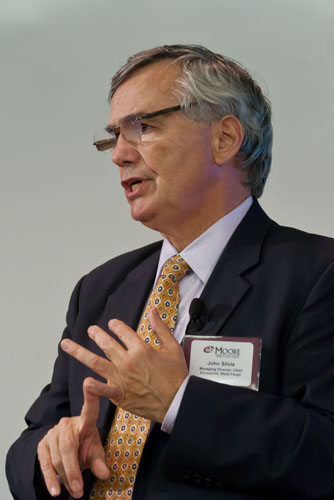Bank’s Annual Economic Outlook Covers Positive Growth in U.S., World-wide Concerns
Wells Fargo’s Economics Group presented its 2017 Annual Economic Outlook this week. The theme of the presentation was “risk and reward in an aging business cycle,” reflecting the potential upsides and downsides to growth.
The presentation emphasized that “there is no life expectancy for the business cycle,” opening with a quote from legendary Indians pitcher Satchel Paige: “How old would you be if you didn’t know how old you are?” This responds to beliefs that the current 90-month period of economic expansion has gone on for too long.
Baseline Economic Case Supports Continued Growth
The bank’s scenarios do not factor in Trump’s recent election or potential policies, as these are still uncertain. However, the report said that a Republican-controlled House, Senate, and White House should facilitate a pivot from monetary to stimulative fiscal policy “at an opportune time,” as “consumer spending has been showing signs of firming and confidence is at the highest levels of the present cycle.”
In the first half of 2017, the bank’s baseline forecast is for 2.0 to 2.5 percent growth, with continued improvement in consumer spending due to job and wage gains as well as a wealth effect from gains in financial markets and home prices.
Business spending is expected to improve as the drag from energy-related cutbacks wanes. Recent labor market surveys indicate a pickup in manufacturing sector openings and net exports remain a drag on overall growth.
“Look for increased spending coming up due to higher employment, wage growth, and job quality (i.e. full-time vs. part time). Although the job growth rate is slowing, these are ‘better’ jobs,” said Wells Fargo Chief Economist John Silvia.
Regions expected to outpace the overall U.S. growth rate include:
- Southeastern states such as Florida,
- Western states including California, Nevada, and Arizona.
Important Forecasts for Oil and Gas
The bank’s main predictions that would impact the oil and gas industry include:
- 2017 growth is forecasted at 2 to 2.5%, with core domestic demand accelerating and trade growth dragging.
- The dollar is expected to strengthen modestly against other currencies over the next year against the backdrop of Fed tightening.
- The yield curve will flatten, with the Fed raising short-term interest rates once in 2017 and twice in 2018.
- Real GDP growth is expected to build momentum in 2017, as consumer spending remains solid and business fixed investment rebounds.
- Average hourly earnings growth is increasing but remains limited by younger, less skilled workers entering the workforce and older, more skilled workers leaving it.
- Historically low inflation has left consumers complacent about inflation risks. Wage increases have accelerated and the benefit provided by lower energy prices has passed.
- Energy has been a significant drag on business investment levels since oil collapsed, although capital spending has decreased across the board during 2016.
Potential Growth Threats
While the bank’s U.S. economic outlook is generally positive, Global Economist Jay Bryson identified four potential downside risks from foreign credit and politics:
- Debt crisis in China – Sharp rises in housing prices are raising concerns about a potential property bubble. The report noted that Chinese banks are better positioned to withstand mortgage write-downs than U.S. banks in 2008.
- Eurozone sovereign debt crisis–The outcome of French elections in April and German elections later in the year will be in focus. Financial turbulence has followed sovereign debt crises in the past. The bank noted that the U.S. would not come through unscathed in a deep recession scenario for Europe.
- “Hard” Brexit –The window to negotiate the U.K.’s future relationship to the E.U. will be open until 2019. A “soft” Brexit would result in relationship like current U.S.-U.K.; free movement of goods and services but not people. “Hard” exit would bring financial volatility back.
- Trade war – President-elect Trump’s vow to renegotiate or scrap NAFTA could restrict U.S. trade with Mexico and Canada, raising import prices. This would weigh on income growth and depress consumer spending. Imposition of tariffs on China and a retaliation would lead to trade war, a damaging situation for both economies.
Foreign economic crises would affect the U.S. directly through slower growth or contraction in exports, although the small percentage of exports (13%) composing U.S. GDP means foreign downturns would have to be very significant. The indirect effects of jittery financial markets would also contribute to slowing U.S. economic growth.
Positive Effects of Lower Oil Prices “Understated;” Demand Growth Needed Most of All
When asked during Q&A if the oil price drop burdened the economy, Silvia disagreed. “Remember, the consumer is the overwhelming driving factor of the economy and lower energy prices result in lower inflation. Wage gains in other sectors have exceeded inflation, thus real consumer spending was boosted by the price decline as the benefits of low oil prices spread.”
Silvia noted that the real limiting factor on energy investment was “volatility and uncertainty of oil prices,” elaborating that “what really needs to happen is stronger global economic growth, not OPEC cuts. Dramatic increases in production outside of OPEC or from Libya or Nigeria can easily keep prices down. When considering the falling costs of U.S. production and the amazing discoveries we’ve made here, the increased growth from higher oil prices could potentially overwhelm any increase in demand we see.”




